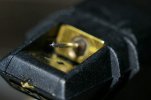On the ones that have an irrepleaceable low ETM cantilever, it is worthwhile getting the stylus refurbished, and the cantilever retipped.I
Stylii are like jewels, some are more perfect than others. Regarding old stylii there is also the suspension issue. Rubber age.
A beryllium or boron tube cantilever, is a product that no longer exists on the market.
Care needs to be taken with who you get to work on it however, as many retippers simply cut off the cantilever and fit a new cantilever/needle (which they purchase from namiki as a complete unit.... at a guess).
The really good retippers, will preserve that irreplaceable cantilever, replace the suspension, and fit a new needle (of your chosen profile).


